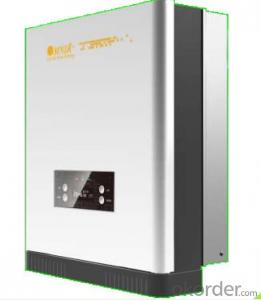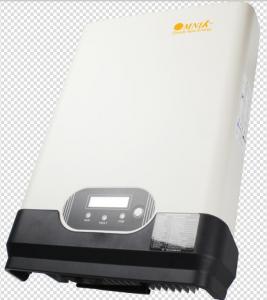on grid solar inverter Omniksol-5.0k-TL2
- Loading Port:
- Shanghai
- Payment Terms:
- TT OR LC
- Min Order Qty:
- -
- Supply Capability:
- 3000 pc/month
OKorder Service Pledge
OKorder Financial Service
You Might Also Like
Omnik new energy solar inverter
Omniksol-2.0k-TL Photon Efficiency up to 3kW
in the world------ Photon tested Jan. 2012.
Omniksol-3k-TL2
Futures
Transformerless design, high efficiency (Max.97.8%,Euro. 97.3%)
Multi -button touch interphase
build in GPRS,WIFI as optional
Smaller,lighter, 5KW,16kg
IP 65 design, suitable for indoor and outdoor installation
10 years warranty(10~25 years as option)
technical data:
Type | Omniksol-3.0k-TL | Omniksol-4.0k-TL | Omniksol-5.0k-TL |
Max. PV-Generator Power [W] | 3400 | 4600 | 5200 |
Max. DC voltage [V] | 590 | 590 | 590 |
MPPT DC voltage Range [V] | 120-500 | 120-500 | 120-500 |
Turn off DC voltage [V] | 90 | 90 | 90 |
Max. DC Current [A] | 12*2 | 16*2 | 18*2 |
Nominal DC Current [A] | 10*2 | 13*2 | 14*2 |
Number of DC Connection | 2 | 2 | 2 |
DC-Connection | MC4 | MC4 | MC4 |
Number of MPP trackers Turn on Power [W] | 2 | 2 | 2 |
Turn on power(W) | 10 | 10 | 10 |
- Q:Can a solar inverter be used with a wireless communication system?
- Yes, a solar inverter can be used with a wireless communication system. In fact, many modern solar inverters are designed with built-in wireless communication capabilities to allow for monitoring and control of the system remotely. This enables users to access real-time data, adjust settings, and receive notifications about the performance of their solar power system through a wireless connection, such as Wi-Fi or cellular networks.
- Q:What is the role of a maximum power point tracker (MPPT) in a solar inverter?
- In a solar inverter, the maximum power point tracker (MPPT) plays a crucial role in optimizing the efficiency and power output of the solar panel system. Since solar panels generate direct current (DC) electricity while most appliances and the electrical grid operate on alternating current (AC), the MPPT continuously adjusts the operating conditions of the solar panels to extract the maximum power available from sunlight. The MPPT tracks the maximum power point (MPP) at which the solar panels can efficiently generate the most electricity. This is vital because the output of a solar panel depends significantly on factors like temperature, shading, and the angle of the sun. To ensure maximum power output, the MPPT continuously monitors and adjusts the voltage and current of the solar panel system, keeping it at the MPP. It achieves this by dynamically altering the electrical load on the solar panels to find the optimal operating point. Additionally, the MPPT acts as a converter, transforming the DC power generated by the solar panels into the AC power required for appliances or for feeding back into the electrical grid. This conversion process involves adjusting the voltage and frequency of the electricity to match the requirements of the appliances or the grid. In summary, the primary function of a maximum power point tracker in a solar inverter is to optimize the efficiency and power output of the solar panel system, ensuring the extraction of the maximum amount of energy from sunlight and its effective utilization for various applications.
- Q:What is the role of Maximum Power Point Tracking (MPPT) in a solar inverter?
- The role of Maximum Power Point Tracking (MPPT) in a solar inverter is to optimize the power output from the solar panels by constantly adjusting the voltage and current to ensure that the solar panels are operating at their maximum power point. This allows the solar inverter to efficiently convert the DC power generated by the solar panels into AC power for use in homes or businesses. By tracking and adjusting the maximum power point, MPPT technology maximizes the overall energy production and improves the overall efficiency of the solar inverter system.
- Q:What is the role of ground fault protection in a solar inverter?
- The role of ground fault protection in a solar inverter is to detect and respond to any faults or abnormalities in the electrical system, specifically related to the grounding of the system. It ensures the safety of the inverter, the solar panels, and the overall electrical system by interrupting the flow of current in the event of a ground fault, preventing potential electric shock hazards and damage to the equipment.
- Q:How do you choose the right size solar inverter for your system?
- To choose the right size solar inverter for your system, you need to consider the total power output of your solar panels and the maximum power rating of the inverter. It is important to match the inverter's capacity with the maximum power output of your solar panels to ensure optimal performance and efficiency. Additionally, factors such as the type of system (off-grid or grid-tied) and future expansion plans should also be taken into account when determining the appropriate size of the solar inverter for your system.
- Q:How does a solar inverter prevent reverse current flow?
- A solar inverter prevents reverse current flow by using built-in diodes that act as one-way valves, allowing electricity to flow only in the desired direction from the solar panels to the grid or battery system.
- Q:What is the role of capacitors in a solar inverter?
- The role of capacitors in a solar inverter is to store and release electrical energy. They help to stabilize the voltage and current, ensuring a smooth and continuous flow of power. Capacitors also help to filter out any unwanted noise or fluctuations in the electrical signal, thus improving the overall performance and efficiency of the solar inverter.
- Q:How do you calculate the maximum power point voltage for a solar inverter?
- To calculate the maximum power point voltage for a solar inverter, you need to determine the voltage at which the solar panels generate the maximum power output. This is done by varying the load resistance and measuring the corresponding power output. The maximum power point voltage is the voltage at which the power output is highest.
- Q:Can a solar inverter be used in areas with high levels of electromagnetic interference (EMI)?
- Yes, a solar inverter can be used in areas with high levels of electromagnetic interference (EMI) as long as the inverter is designed and tested to withstand such conditions. Inverters with robust shielding and advanced filtering mechanisms can effectively mitigate the effects of EMI, ensuring stable and reliable operation even in challenging electromagnetic environments.
- Q:Can a solar inverter be used in a mobile or portable solar system?
- Yes, a solar inverter can be used in a mobile or portable solar system. Portable solar systems typically consist of solar panels, a battery, and an inverter. The solar panels generate electricity from the sun, which is stored in the battery. The inverter then converts the stored DC power from the battery into AC power that can be used to power various devices and appliances. This allows for the utilization of solar energy even in remote or mobile settings.
1. Manufacturer Overview |
|
|---|---|
| Location | |
| Year Established | |
| Annual Output Value | |
| Main Markets | |
| Company Certifications | |
2. Manufacturer Certificates |
|
|---|---|
| a) Certification Name | |
| Range | |
| Reference | |
| Validity Period | |
3. Manufacturer Capability |
|
|---|---|
| a)Trade Capacity | |
| Nearest Port | |
| Export Percentage | |
| No.of Employees in Trade Department | |
| Language Spoken: | |
| b)Factory Information | |
| Factory Size: | |
| No. of Production Lines | |
| Contract Manufacturing | |
| Product Price Range | |
Send your message to us
on grid solar inverter Omniksol-5.0k-TL2
- Loading Port:
- Shanghai
- Payment Terms:
- TT OR LC
- Min Order Qty:
- -
- Supply Capability:
- 3000 pc/month
OKorder Service Pledge
OKorder Financial Service
Similar products
New products
Hot products
Hot Searches
Related keywords































